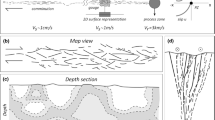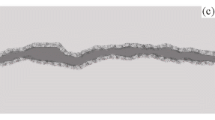Abstract
The inhomogeneity of materials with different physical properties is responsible for a wide variety of spatial and temporal behavior. In this work, we studied an earthquake fault model based on the Olami–Feder–Christensen and Rundle–Jackson–Brown cellular automata models with particular aspects of spatial heterogeneities and long-range stress interactions. In our model some localized stress accumulators were added into the system by converting a percentage of randomly selected sites into stronger sites that are called ‘asperity cells’. These asperity cells support much higher failure stresses than the surrounding regular lattice sites but eventually rupture when applied stress reaches their threshold stress. We found that changing the spatial configuration of those stronger sites generally increased the ability of the fault system to generate larger events, but that the total percentage of asperities is important as well. We also observed an increasing number of larger events associated with the total number of asperities in the lattice.









Similar content being viewed by others
References
Alava, M. J., Nukala, P., and Zapperi, S. (2006), Statistical models of fracture, Adv. Phys. 55, 349.
Bach, M., Wissel F. and Dressel, B. (2008), Olami-Feder-Christensen model with quenched disorder. Phys. Rev. E77, 067101.
Bak, P., Tang, C. and Weisenfeld, K. (1987), Self-organized criticality: an explanation of 1/f noise. Phys. Rev. A 38, 364–374.
Burridge, R., Knopoff, L. (1967), Model and theoretical seismicity, Bull. Seismol. Soc. Am. 57, 341–371.
Carlson, J. M., Langer, J. S. and Shaw, B. E. (1994). Dynamics of earthquake faults. Rev. Mod. Phys. 66, 657.
Carlson J.M., Langer, J., Shaw, B., Tang, C. (1991). Intrinsic properties of a Burridge-Knopoff model of an earthquake fault. Phys. Rev. A 40, 884.
Carlson, J. M. and Langer, J. S. (1989), Mechanical model of an earthquake fault. Phys. Rev. Lett. 62, 2632; Phys. Rev. A 40, 6470.
Ceva, H. (1995), Inhuence of defects in a coupled map lattice modelling earthquakes. Phys. Rev, E52, 154.
Clancy, I. and Corcoran, D. (2005). Criticality in the Burridge-Knopoff model. Phys. Rev. E 71, 046124.
Clancy, I. and Corcoran, D. (2006). Burridge-Knopoff model: Exploration of dynamic phases. Phys. Rev. E 73, 046115.
Dahmen, K., Ertas, D., and Ben-Zion, R. (1998), Gutenberg-Richter and Characteristic Earthquake Behavior in Simple Mean-field Models of Heterogeneous Faults, Phys. Rev. E 58, 1494–1501.
Dominguez, R., Tiampo, K.F., Serino, C.A. and Klein W. (2013), Scaling of earthquake models with inhomogeneous stress dissipation. Phys. Rev. E 87, 022809.
Dominguez, R., Tiampo, K., Serino, C. A. and Klein, W. (2012). Characterizing Large Events and Scaling in Earthquake Models with Inhomogeneous Damage. Geophysical Monograph Series. 196, 41–54. doi:10.1029/2011GM001082.
Gutenberg, B. and Richter, C.F. (1956), Magnitude and energy of earthquakes. Annali di Geofisica, Vol. 9, n. 1.
Herz, A.V.M., and Hopfield, J.J. (1995), Earthquake Cycles and Neural Reverberations, Collective Oscillations in Systems with Pulse-Coupled Threshold Elements. Phys. Rev. Lett., 75, 1222–1225.
Jagla, E.A. (2010), Realistic spatial and temporal earthquake distributions in a modified Olami-Feder-Christensen model. Phys. Rev, E81, 046117.
Janosi, I.M. and Kertesz, J. (1993), Self-organized criticality with and without conservation. Physica (Amsterdam) A200, 179.
Kanamori, H. (1981), The nature of seismicity patterns before large earthquakes, in Earthquake Prediction, Maurice Ewing Series, IV, 1–19, AGU, Washington D.C..
Klein, W., Gould, H., Gulbahce, N., Rundle, J. B. and Tiampo, K. (2007), Structure of fluctuations near mean-field critical points and spinodals and its implication for physical processes. Phys. Rev. E 75, 031114.
Langer, J.S. (1992). Models of crack prorogation. Phys. Rev. A 46, 3123.
Lyakhovsky, V. and Ben-Zion, Y. (2009), Evolving geometrical and material properties of fault zones in a damage rheology model, Geochem. Geophys. Geosyst., 10, Q11011.
Main, I. (1996), Statistical physics, seismogenesis, and seismic hazard. Rev. Geophys. 34, 433–462.
Mori T. and Kawamura, H. (2006). Simulation study of the one-dimensional Burridge- Knopoff model of earthquakes. J. Geophys. Res. 111, B07302.
Mori T. and Kawamura, H. (2005). Simulation study of spatiotemporal correlations of earthquakes as a stick-slip frictional instability. Phys. Rev. Lett. 94, 058501.
Mousseau, N. (1996), Synchronization by Disorder in Coupled Systems. Phys. Rev. Lett. 77, 968.
Nakanishi, H. (1990), Cellular-automaton model of earthquakes with deterministic dynamics. Phys. Rev. A 41, 7086.
Olami, Z., Feder, HJS., Christensen, K. (1992), Self-organized criticality in a continuous, nonconservative cellular automaton modelling earthquakes. Phys Rev Lett 68(8):1244–1247.
Ogata, Y. (1983), Estimation of the parameters in the modified Omori formula for aftershock frequencies by the maximum likelihood procedure, Journal of Physics of the Earth, Vol.31, 115–124.
Otsuka, M. (1972), A Simulation of earthquake occurrence. Phys Earth Planet Inter. 6–311.
Ramos, O., Altshuler, E. and Maloy K.J. (2006), Quasiperiodic Events in an Earthquake Model. Phys. Rev. Lett. 96, 098501.
Rundle, J.B., Turcotte, D.L., Shcherbakov, R., Klein, W., Sammis, C., (2003), Statistical physics approach to understanding the multiscale dynamics of earthquake fault systems. Review of Geophysics, 41, 1019.
Rundle, J. B., Klein, W., Tiampo, K. and Gross S., (2000), Linear pattern dynamics in nonlinear threshold systems, Phys. Rev. E, 61 (3), 2418–2431.
Rundle, JB, Klein W. and Gross S. (1999), Physical basis for statistical patterns in complex earthquake populations: Models, predictions, and tests, PAGEOPH, 155, 575–607.
Rundle, J. B. and Brown, S. R. (1991), Origin of Rate Dependence in Frictional Sliding, J. Stat. Phys. 65, 403.
Rundle, J. B. (1988), A physical model for earthquakes, J. Geophys. Res. 93–6237.
Rundle, J. B. and Jackson, D. D. (1977), Numerical simulation of earthquake sequences, Bull. Seismol. Soc. Am. 67.
Serino, C. A., Tiampo, K. F. and Klein W. (2011), New Approach to Gutenberg-Richter Scaling, Phys. Rev. Lett. 106, 108501.
Scholz, C.H. (2002), The mechanics of earthquakes and faulting, Cambridge University Press, p. 471.
Schorlemmer, D., and Gerstenberger, M. C. (2007), RELM testing center, Seismol. Res. Lett. 78, 1, 30–36.
Tiampo, K. F., Rundle, J. B., Klein, W., Holliday, J., S´aMartins, J. S. and Ferguson, C. D. (2007), Ergodicity in natural earthquake fault networks. Phys. Rev. E 75, 066107.
Tiampo, K.F., Rundle, J.B., McGinnis, S., Gross, S., Klein, W. (2002), Mean-field threshold systems and phase dynamics: an application to earthquake fault systems. Eur. Phys. Lett. 60, 481–487.
Torvund F., and Froyland, J. (1995), Strong ordering by non-uniformity of thresholds in a coupled map lattice. Physica Scripta 52, 624.
Turcotte, D.L., Newman, W.I., Shcherbakov, R. (2003), Micro and macroscopic models of rock fracture. Geophysical Journal International 152, 718–728.
Turcotte, D. L. (1997), Fractals and chaos in geology and geophysics, 2nd edn. Cambridge, UK: Cambridge University Press.
Utsu, T., Ogata, Y. and Matsu’ura, R. S. (1995), The centenary of the Omori formula for a decay law of aftershock activity, Journal of Physics of the Earth, Vol.43, pp.1–33.
Vasconcelos, G. L., (1996). First-order phase transition in a model for earthquakes. Phys. Rev. Lett. 76, 4865.
Vasconcelos, G. L., (1992). Phase transitions in a spring-block model of earthquakes. Physica A 191, 69.
Vere-Jones, D. (2006), The development of statistical seismology, A personal experience. Tectonophysics 413, 5–12.
Vere-Jones, D. (1995), Forecasting earthquakes and earthquake risk. International Journal of Forecasting 11, 503–538.
Xia, J., Gould, H., Klein, W., Rundle J. B. (2008). Near-mean-field behavior in the generalized Burridge-Knopoff earthquake model with variable-range stress transfer. Phys. Rev. E 77 (2008), 031132.
Xia, J., Gould, H., Klein, W., Rundle J. B. (2005). Simulation of the Burridge-Knopoff model of earthquakes with variable range stress transfer. Phys. Rev. Lett. 95, 248501.
Zechar, J.D., Jordan, T.H. (2010), Simple smoothed seismicity earthquake forecasts for Italy. Annals of Geophysics 53.
Acknowledgments
This research was funded by the NSERC and Aon Benfield/ICLR IRC in Earthquake Hazard Assessment, and an NSERC Discovery Grant (JK and KFT).
Author information
Authors and Affiliations
Corresponding author
Rights and permissions
About this article
Cite this article
Kazemian, J., Dominguez, R., Tiampo, K.F. et al. Spatial Heterogeneity in Earthquake Fault-Like Systems. Pure Appl. Geophys. 172, 2167–2177 (2015). https://doi.org/10.1007/s00024-014-0843-6
Received:
Revised:
Accepted:
Published:
Issue Date:
DOI: https://doi.org/10.1007/s00024-014-0843-6




